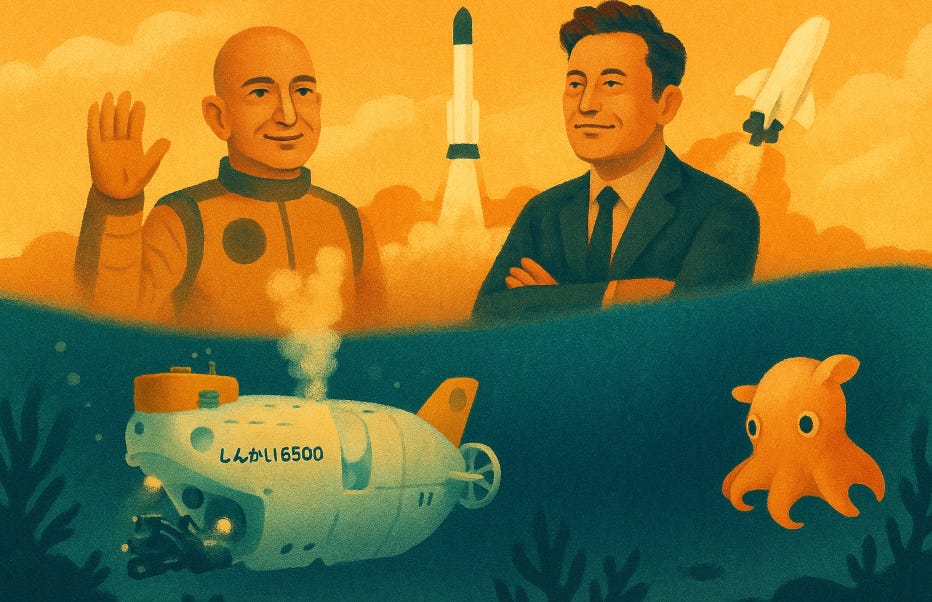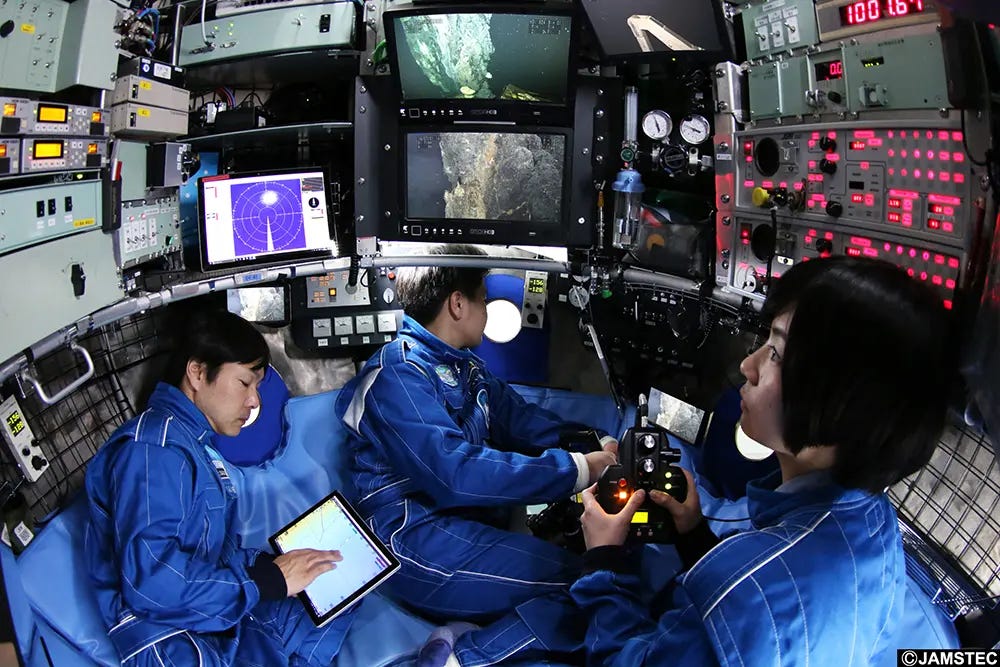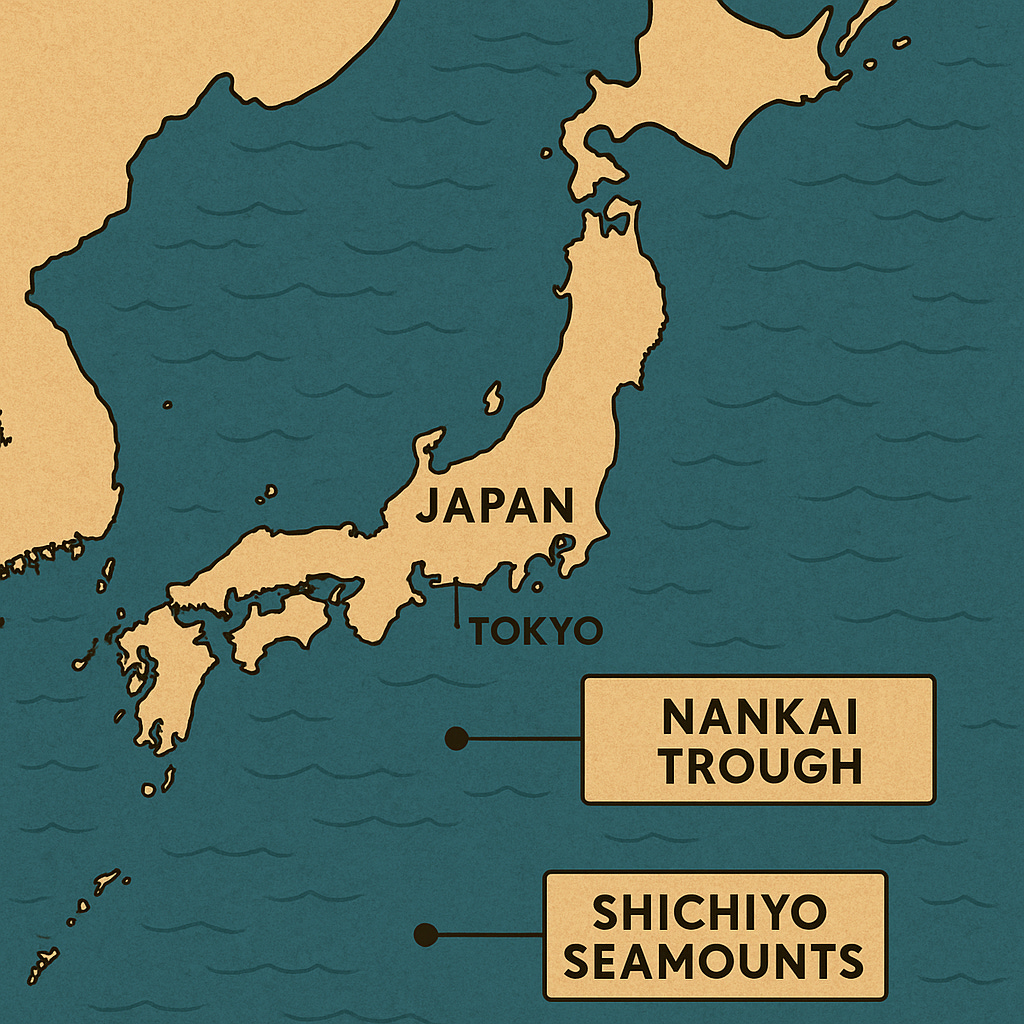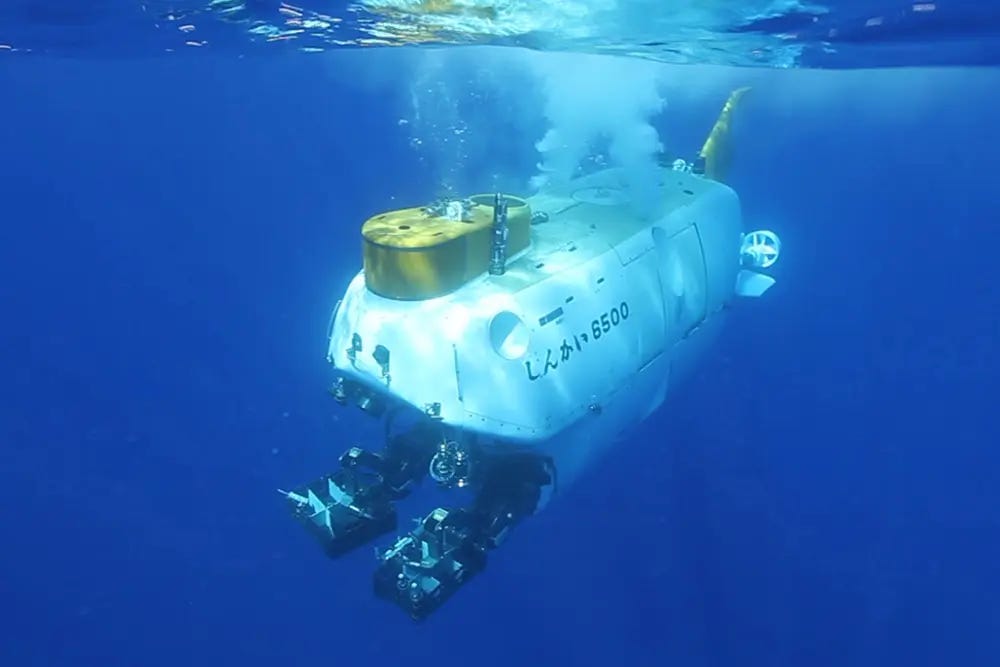Everyone is Looking at Elon and Jeff, but the Deep Sea Doesn’t Trend
An extraordinary deep-sea expedition is happening right now. It could rewrite what we know about life on Earth. You probably haven’t heard about it.
Welcome to The Current. Your Saturday morning dispatch from the front lines of our blue planet. This is your space on a Saturday morning to be still, breathe and reflect. Each week, I take a closer look at the headlines, research and rhetoric shaping our relationship with the sea. I try to go deeper, to catch the currents under the spin, and surface with something worth holding onto.
While Musk toyed with Mars and Bezos geared up for another high-altitude joyride, a quieter mission launched 4,500 metres beneath the sea, the JAMSTEC–Shinkai Expedition 2025. No rocket. No front page. Just science in search of life no one has ever seen.
Partnering with the Nippon Foundation-Nekton Ocean Census initiative, the Japan Agency for Marine-Earth Science and Technology (JAMSTEC) has deployed its Shinkai 6500 submersible on a 20-day scientific voyage to explore some of the most biologically rich, least-explored regions of Japan’s Exclusive Economic Zone. The expedition marks Japan’s flagship contribution to the Ocean Census, the world’s largest programme to accelerate marine species discovery, launched in 2023 and endorsed by the UN Ocean Decade.
I think the tagline of Ocean Census is wonderful and so very true; To understand life, and sustain it, we must first discover it.
“This expedition represents more than a journey into the unknown,” said Dr Takeshi Kawano, executive director at JAMSTEC. “It signifies a convergence of knowledge, expertise, and a shared vision dedicated to advancing the discovery of marine biodiversity.”
Despite the incredible advances in exploratory technology, there is risk.
My first thought when I was reading about this expedition was the Titan submersible that imploded, in June 2023, during a private expedition to the Titanic wreck, killing all five people onboard. Despite its beauty, the ocean will always remain hostile, unforgiving and unpredictable. It is not a tourist attraction. It is a place of real danger, and real discovery. That is what makes this expedition extraordinary. The scientists aboard Shinkai 6500 know the risks. They go anyway.
I desperately wanted to name the crew in this article, because they deserve to be named. They should be classed as heroes. They should be household names. These researchers are in darkness and pressure, pushing the boundaries of knowledge for all of us.
At the time of writing, the names of those onboard have not been publicly released. They should have their own hashtags and be trending, but they are not. If the submersible were to get into trouble, it would get onto the front page of newspapers around the world. It seems that discovery without drama doesn’t sell, and that is possibly why the deep sea remains invisible.
So, here are a few names from past missions, people who have piloted Shinkai, led sampling efforts and advanced our understanding of the ocean’s hidden life: Dr. Hiroshi Kitazato, one of Japan’s most respected deep-sea biologists. Dr. Hiromi Watanabe, an expert in hydrothermal vent ecosystems. Dr. Karen Miller, a benthic ecologist from the Australian Antarctic Division and ANU. They represent the kind of courage, intellect and humility this work demands.
Whoever is down there today, they stand in that same tradition. They deserve to be seen.
The mission of the JAMSTEC–Shinkai Expedition 2025 is to survey unexplored regions like the Nankai Trough and Shichiyo Seamounts, collecting species that may never have been seen before and making their findings open to the world.
That is how science works.
Quietly. Deeply. Invisibly.
Not on the whims of a billionaire or with a countdown clock sponsored by an energy drink.
What they’re actually doing
The team will undertake ten dives inside Japan’s Exclusive Economic Zone.
These are not the kind of places that Mark Zuckerberg (sorry, Mark, you haven’t escaped this article) would want to visit. These are places where blind crustaceans crawl through volcanic rubble and where methane seeps are home to strange ecosystems powered by chemicals instead of sunlight. Places shaped by pressure, darkness and silence.
The team will:
Collect genetic samples from undiscovered species
Catalogue micro-life in the sediment, from copepods (tiny crustaceans) to tardigrades (tiny eight-legged creatures known for surviving in extreme conditions)
Map ecosystems in the Nankai Trough and Shichiyo Seamounts
Use high-resolution cameras to record living organisms in their habitat
Share every finding open-access via the Ocean Census Biodiversity Platform
While Billionaires Chase the Sky, Earth’s Greatest Mysteries Remain Unexplored
There are around 2,800 billionaires on Earth, with a combined wealth of over $14 trillion. Collectively, they could end world hunger, fund universal education, or fully protect the entire ocean, overnight.
Instead, when wealth reaches a certain altitude, something strange happens. The inner child resurfaces, zipped into a flight suit, demanding a countdown. World domination gets dull, so they pivot to space. Not for science. Not for survival. For the spectacle. The ascent. The livestream. They build rockets not because we need a lifeboat, but because Earth no longer feels big enough to contain their egos.
Meanwhile, the Shinkai team descend in silence.
No launch pads. No champagne. No capsule selfies. Just science. Slow, methodical, meticulous. Sealed inside a titanium sphere, they dive into the dark to sample microbes, map volcanic vents and document life no one has ever seen before. They then make all the data freely available to the world.
The obsession with space has always unsettled me. It feels less like adventure, more like escape. A glossy exit strategy. A way of saying we failed this planet, but don’t worry, we’ll build a new one on Mars.
We won’t. We shouldn’t.
We haven’t even finished discovering this one. We’ve mapped more of the Moon than our own seabed. We understand distant galaxies better than we understand the microbial life keeping our biosphere stable. That ignorance isn’t just embarrassing.
It’s dangerous.
The ocean sustains us. It regulates our climate, produces most of our oxygen, feeds billions and holds the keys to medicine, biodiversity and resilience in a warming world. Yet we still invest more in billionaires playing spaceman than in understanding the only system keeping us alive.
That’s why this mission matters.
The Shinkai 6500 may not trend on Twitter. It won’t pull TV ratings. Instead, it brings us closer to the real frontier, the one we’re already part of.
The one we’ve barely begun to understand.
The one we still have time to save.
We need to cover the ocean like we cover rockets
If we look at the USA alone, the imbalance is staggering. In 2024, NASA received nearly $25 billion, while the agency responsible for ocean exploration, NOAA’s Office of Ocean Exploration and Research, was given just $46 million. That is more than 500 times less funding to explore the ocean than space.
$25 billion versus $46 million. That’s a red flag.
We don’t just have a science funding gap. We have an attention economy problem. Media visibility is driven by viewership. Viewership drives ad spend. So, the stories that trend are the ones that sell… billionaires launching themselves into the stratosphere, not scientists diving into the unknown. The deep sea doesn’t pull ratings. There are no explosions, no celebrities, no capsule re-entries. Just life. Quiet, miraculous life. Which in today’s media landscape, is not enough. Until we fix that, the most important discoveries on Earth will remain invisible.
This isn’t just about money. It’s about priorities. More than 90% of marine species remain undescribed by science. Yet we continue to chase the stars, while ignoring the life systems that actually keep us alive.
From the boiling vents of the Mariana Trench to the icy grip of Antarctica’s subglacial lakes, Earth’s deep places hold answers we cannot afford to ignore. In 2012, scientists drilled into Lake Vostok, sealed under Antarctic ice for over 15 million years. What they found wasn’t just ancient water, it was DNA from more than 3,500 organisms, some adapted to total darkness, feeding off minerals in the bedrock. Life that rewrites the rules of what is possible.
Just last year, a team aboard the Schmidt Ocean Institute's R/V Falkor discovered over 100 previously unknown species off the coast of Chile, including bubblegum corals and bioluminescent anemones clinging to ancient seamounts.
We should be following every dive, every discovery, every moment of awe. We should be making this exciting, not obscure. If we treated deep-ocean exploration the way we treat space launches, we might actually understand the planet we live on and how to save it.
We should be crowded around TV sets like it’s the 1969 Apollo 11 moon landing. At the very least, there should be headlines. Updates. Live coverage. Katy Perry got news coverage for floating in the upper atmosphere, in Jeff Bezos’ Blue Origin, for less time than it takes to hard boil an egg. Meanwhile, scientists in full submersion for eight-hour shifts, searching for life no one has ever seen, do so in total silence.
This is about humility. About wonder. About remembering that the greatest frontier is not always the one farthest away, sometimes it’s the one just out of sight.
In the dark, life thrives. In the silence, stories wait to be told.
While some are queuing for the stars, others are already descending. Into trenches. Into canyons. Into places not only unexplored, but unimagined.
We owe it to them, the scientists, the creatures, the deep itself, to pay attention.
Not just because it’s fascinating, but because the future depends on what we choose to see.
📌 PS – Please consider restacking or sharing if this piece struck a chord, it helps raise the alarm and fuels this kind of independent ocean journalism that challenges, informs and (hopefully) makes a difference.








